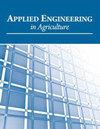Mapping Agricultural Drainage Extent in the U.S. Corn Belt: The Value of Multiple Methods
IF 0.8
4区 农林科学
Q4 AGRICULTURAL ENGINEERING
引用次数: 2
Abstract
Highlights A new 30 m resolution drainage extent dataset is explorable through an online web interface. Alternative methods of mapping drainage extent have advantages in different locations. Multiple drainage extent datasets provide tools for improved hydrology assessment in the Corn Belt. Abstract. Artificial drainage is essential to agricultural productivity in much of the Midwest, and has an important impact on hydrology and water quality. Planners, engineers, resource professionals, and others who are interested in Corn Belt hydrology would benefit from increased understanding of existing drainage installations. The objective of this work is to increase access to and understanding of options for estimating subsurface/surface drainage extent and the advantages and disadvantages of different methods to benefit data users who need to know what products are appropriate for their specific application. This includes creating an online accessible drainage estimate data layer for the entire Corn Belt region; comparing three different drainage extent products for this region and investigating the various applications of these three products in four case study locations in Indiana, Iowa, Missouri, and Minnesota. Results show how different drainage datasets can be utilized depending on the nature of the research question and conditions of the investigation. Keywords: Agricultural drainage extent, Geospatial analysis, Tile drainage.绘制美国玉米带农业排水范围:多种方法的价值
一个新的30米分辨率的排水范围数据集可以通过在线web界面进行探索。在不同的位置,不同的水系范围制图方法各有优势。多种流域范围数据集为改进玉米带水文评价提供了工具。摘要在中西部大部分地区,人工排水对农业生产力至关重要,并对水文和水质产生重要影响。规划师、工程师、资源专业人士和其他对玉米带水文学感兴趣的人将受益于对现有排水设施的进一步了解。这项工作的目的是增加对估计地下/地表排水范围的选择的访问和理解,以及不同方法的优缺点,以使需要知道哪些产品适合其特定应用的数据用户受益。这包括为整个玉米带地区创建一个在线可访问的排水估计数据层;比较了该地区三种不同的排水范围产品,并在印第安纳州、爱荷华州、密苏里州和明尼苏达州的四个案例研究地点调查了这三种产品的各种应用。结果显示了如何根据研究问题的性质和调查条件利用不同的排水数据集。关键词:农业排水程度地理空间分析瓦排水
本文章由计算机程序翻译,如有差异,请以英文原文为准。
求助全文
约1分钟内获得全文
求助全文
来源期刊

Applied Engineering in Agriculture
农林科学-农业工程
CiteScore
1.80
自引率
11.10%
发文量
69
审稿时长
6 months
期刊介绍:
This peer-reviewed journal publishes applications of engineering and technology research that address agricultural, food, and biological systems problems. Submissions must include results of practical experiences, tests, or trials presented in a manner and style that will allow easy adaptation by others; results of reviews or studies of installations or applications with substantially new or significant information not readily available in other refereed publications; or a description of successful methods of techniques of education, outreach, or technology transfer.
 求助内容:
求助内容: 应助结果提醒方式:
应助结果提醒方式:


